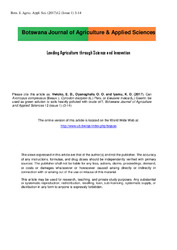| dc.contributor.author | Vwioko, E. D. | |
| dc.contributor.author | Oyanoghafo, O. O. | |
| dc.contributor.author | Iyamu, K. O. | |
| dc.date.accessioned | 2019-10-09T08:33:51Z | |
| dc.date.accessioned | 2021-03-15T08:44:51Z | |
| dc.date.available | 2019-10-09T08:33:51Z | |
| dc.date.available | 2021-03-15T08:44:51Z | |
| dc.date.issued | 2017 | |
| dc.identifier.citation | Vwioko, E. D., Oyanoghafo, O. O. and Iyamu, K. O. (2017). Can Axonopus compressus (Beauv.), Cynodon dactylon (L.) Pers. or Eleusine indica (L.) Gaertn. be used as green solution to soils heavily polluted with crude oil?. Botswana Journal of Agriculture and Applied Sciences 12 (issue 1) (3-14) | en_US |
| dc.identifier.issn | 1815-5574 | |
| dc.identifier.uri | https://bojaas.buan.ac.bw/index.php/jaas | |
| dc.identifier.uri | http://moodle.buan.ac.bw:80/handle/123456789/221 | |
| dc.description | Research article | en_US |
| dc.description.abstract | The objective of this study is to assess the survival of three grass species, Axonopus compressus (Beauv.), Cynodon dactylon (L.) Pers, and Eleusine indica (L.) Gaertn. in crude oil polluted soil and propose an explanation for their responses. Top Ultisol soils (0-15 cm depth) collected from demonstration farm were pooled to make composite sample, air-dried and sieved (˂2mm). Experimental pots were prepared from the composite sample and individually treated with 0%, 10% or 20% (w/w) crude oil by gradual manual mixing. Ten equally sized stumps of a grass species were sown in a pot. Each species had 9 pots representing three replicates per oil treatment, arranged in a completely randomized design. Parameters assessed were plant height, number of leaves, stem circumference, leaf length, root length and biomass. Soil pH was monitored every 2 weeks for 10 weeks. Total petroleum hydrocarbon (TPH) content and GC-FID analyses of soil samples before and after plant growth were done. Bacterial species associated with the soil samples after plant harvest were determined. Growth of the test species were suppressed by oil when compared to plants grown in unpolluted soil. Mean height of A. compressus plants recorded 10 weeks after planting (WAP) were 24.37, 12.27 and 9.78 cm for 0, 10 and 20% oil polluted soil respectively. C. dactylon and E. indica failed to sustain growth in 20% soil. TPH was reduced from 6.704 to 2.965 mg/kg and 6.176 to 2.032 mg/kg for 10 and 20% soil respectively by A. compressus, 6.704 to 2.503 mg/kg and 6.176 to 1.819 mg/kg for 10% and 20% soil respectively by C. dactylon, and 6.704 to 2.282 mg/kg and 6.176 to 1.522 mg/kg for 10 and 20% soil respectively by E. indica. Soil pH increased from 5.8 – 8.3 and 4.5 - 7.8 in 10 and 20% soil respectively where A. compressus plants were grown. Soil pH where C. dactylon and E. indica plants were grown did not exhibit this. The study suggests that A. compressus is able to sustain growth in 20% crude oil polluted soil by modifying soil pH from acidic to neutral conditions. | en_US |
| dc.language.iso | en | en_US |
| dc.publisher | Botswana University of Agriculture and Natural resources | en_US |
| dc.relation.ispartofseries | Botswana Journal of Agriculture and Applied Sciences;Vol. 12 (Issue 1): 3-14 | |
| dc.subject | Crude oil | en_US |
| dc.subject | Cynodon dactylon | en_US |
| dc.subject | Eleusine indica | en_US |
| dc.subject | Axonopus compressus | en_US |
| dc.subject | soil pollution | en_US |
| dc.subject | survival | en_US |
| dc.title | Can Axonopus compressus (Beauv.), Cynodon dactylon (L.) Pers. or Eleusine indica (L.) Gaertn. be used as green solution to soils heavily polluted with crude oil? | en_US |
| dc.type | Article | en_US |

